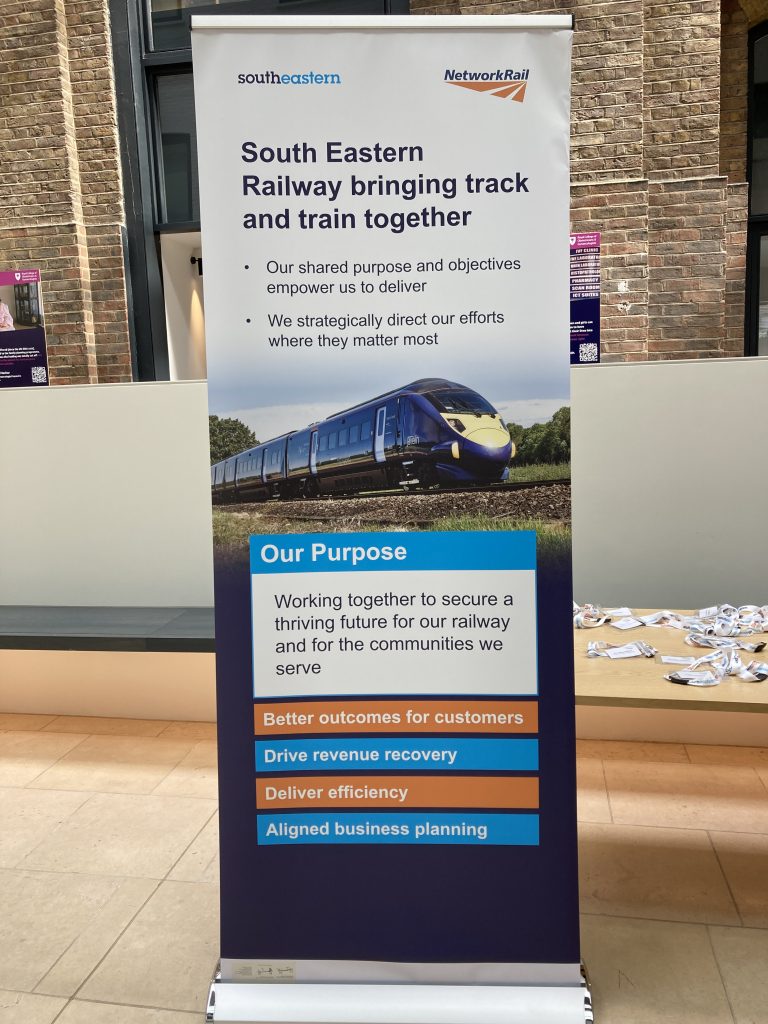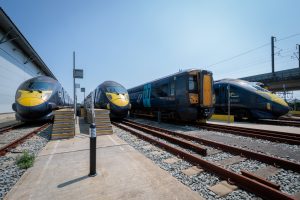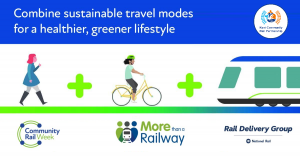South Eastern Railway Stakeholder Forum, 15th July 2025

We were delighted to accept an invitation to attend the South Eastern Railway Stakeholder Forum on Tuesday 15th July, to hear updates and announcements from Southeastern and Network Rail about their integrated working group.
Please find below a summary of our notes from the meeting.
.

Our Integrated Railway
Steve White, Managing Director, South Eastern Railway
Before beginning the business of the day, Steve paused to acknowledge a serious incident on the railway in the preceding days.
“Our thoughts are with the family and loved ones of the van driver who tragically lost their life following a collision with one of our trains on Sunday. No one else was injured in the incident.
We are fully assisting the Rail Accident Investigation Branch with their investigation to understand exactly what happened.
I’d like to thank the emergancy services, our rail colleagues and the RAIB for their swift an professional response – and also our passengers, particularly those on the train involved and others affected by the disruption, for their patience and understanding.”
Our railway – one team, one purpose – South Eastern Railway.
The integrated South Eastern Railway formally began on the 9th June with a public launch at Folkestone on 18th June.
Working as one team, with one purpose is forecast to reduce tax-payer subsidy by £50m in the current financial year, delivering better and more reliable journeys for everyone.
Improvements will be made by ntegrating organisationally, digitally and cuturally with 6,740 employees focused on growing the business, serving customers and doing the right thing.
Investing in people to create a diverse workforce who “dare to care”, recruiting to drive social mobility, offer meaningful career opportunities and deliver a fully resourced railway.
Working as one team, with one purpose is forecast to reduce tax-payer subsidy by £50m in the current financial year, delivering better and more reliable journeys for everyone.
Improvements will be made by ntegrating organisationally, digitally and cuturally with 6,740 employees focused on growing the business, serving customers and doing the right thing.
Investing in people to create a diverse workforce who “dare to care”, recruiting to drive social mobility, offer meaningful career opportunities and deliver a fully resourced railway.

Integrated Operations
Scott Brightwell, Safety, Planning and Performance Director. David Davidson, Chief Operating Officer
Reliability and punctuality drive customer satisfaction, recommendation and business growth.
Achieving this requires high performing colleagues and infrastructure, accurate evaluation of performance and a desire to seek continuous improvement.
There are over 1800 trains running every day over hundreds of miles of track.
Monitoring cameras are being installed on trains to detect potential faults before they become critical, idnetifying opportunities to intervene through scheduled works before incidents that cause serious delays can occur. Thermal imaging cameras on drones can find trespassers or confirm their absence quickly, reducing the length of time power needs to be switched off and trains halted.
Climate change brings many challenges. 2024 saw a 14% dip in service performance for Autumn, timetables will now see more seasonal adjustments to the number of services and their timings to improve reliability. The December timetable will see additional services between Charing Cross and Maidstone East in response to passenger growth and more Kent Downs Line services between Victoria and Ashford.

Integrated Investment In Track, Train and Stations
David Davison, Chief operating Officer. Andrew Wood, Commercial Director
There is an ongoing tender to replace the ageing Networker train fleet, additional class 377 units, and continuing refurbishment work to improve interiors of class 376 stock.
Renewal work is being planned for the motors on the Kingsferry bridge to improve its reliability, new sea defences at Folkestone Warren and a variety of track and signalling work elsewhere in Kent and the London metro area.
Strood, Maidstone West and Sittingbourne stations will be receiving a variety of smaller station improvements, in addition over 100 Southeastern stations will be deep cleaned.
There will be a new station delivered on the Kent Downs Line at the Heathlands development and significant improvements to Westenhanger to support the Otterpool new town.
Schemes are being considered for inclusion in future Access for All programmes, demonstrable local authority support and contributions to funding are key to securing these large scale accessibility improvements.
Integrating To Enhance Customer Experience And Reduce Subsidy
Alicia Andrews, Commercial Director
In 2024/25 Southeastern received £406m in tax-payer subsidy. The forecast is to reduce this to £359m for 2025/26 and achieve further year on year reductions in the future.
This forecast reflects shifting travel patterns with a return to commuter train travel for both work and education. Leisure travel remains an important sector, business travel is proving slower to recover. The 2025/26 forecast would see Southeastern generate more fare income than it made before the Covid pandemic.
Customer satisfaction is key to future growth, Southeastern has high levels of customer satisfaction which it aims to improve.
As more Train Operating Companies join the Department for Transport Operator, more opportunities will arise for ticket acceptance. This is under develpment with South Western Railway and Govia Thameslink Railway.
Accessibility improvements, increasing the volume of Advance fare sales and communicating these offers to customers through partners will be key. This year has already seen the Southeastern Network Weekend with an Advanced tickets sale in collaboration with the Visit Kent Big Weekend, promotion of Groupsave tickets and advertising focusing on modal shift. Southeastern has demonstrated that its marketing generates more income than it costs in delivery.
Digital improvements will continue to be rolled out, offering customers easy ways to donate their change to Kent Wildlife Trust, Track My Journey services to share travel details with friends and family, e-tickets by scanning q/r codes, improved season ticket calculators and open banking options for ticket payments.
Bids for modern Ticket Vending Machines are being evaluated, with installation beginning in January 2026 and expected to roll-out across 165 stations.

Integrated Safety and Security
Mark Sutton, Safeguarding Manager
Workplace violence is on a worsening and worrying trend, although the statistics are influenced by an increased rate of reporting.
British Transport Police logged 7,405 crimes against staff last year, an increase of 8%. Reporting of incidents allows for better targetting of resources to tackle them. There is a zero-tolerance approach to assault and active prosecution of offernders.
There are 48 active 6 month bans on individuals from entering Southeastern stations and using services. An effective way to close the door and keep out those who cause anti-social behaviour.
However, effective safeguarding on the railway changes lives and saves lives. Early intervention through education and empathy are the best ways to make the railway safer.
2,400 colleagues have been trained to support vulnerable people, 382 people have been saved from taking their own lives, 207 colleagues have been engaged on tackling violence against women and girls. Southeastern and South Western Railway hosted the first national railway safeguarding conference in May.

Integrated Travel
Freya Alder, Integrated Transport Manager
Nationally, 62% of people poit to the lack of end-to-end journeys as a key reson for not choosing rail. In the Southeastern region the top 3 customer challenges when leaving the station are:
21% – traffic in and out of the station. 16% – cost of public transport. 13% – lack of transport connections.
Sooutheastern’s vision: “Our railway at the heart of an integrated transport system that supports the communities we serve – socially, economically and environmentally.”
Southeastern’s mission: “To create seamless door-to-door journeys for everyone by better integrating rail with active, shared and public transport.”
Currently 60% of Southeastern customers think of the car first for journeys and around 40% of customers using stations in Kent arrive their by car.
To achieve modal shift for first and final miles the key challenges are car dominated environments, poor active and public transport provision and transport-related social exclusion. Tackling these issues will lead to better access to work, education, healthcare, essential services and leisure activities.
Southeastern’s prioirities for integrated travel are:
Enhancing first and last mile options
Expanding first and last mile options
Improving station facilities
Promoting sustainable travel
Developing policy and standards
Gathering insights and planning improvement
Projects will include improving shared bike parking, facilitating “Reach the Beach” buses, promoting sustainable days out with leisure partners, developing Station Travel Plans.

Closing Remarks
Steve White
South Eastern Railway has set out a plan covering its ambition for the next 12 months.
Integration continues at pace, with more Train Operating Companies joining the Department for Transport Operator and moving closer together.
There will be further Railway 200 celebrations as the exhibition train “Inspiration” visits Margate on 20-21 July, the Southeastern Ashford Depot holds an open day on 24 August and a Networker rail tour is being planned for 27 September.
![]()